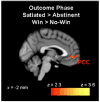Smoking withdrawal is associated with increases in brain activation during decision making and reward anticipation: a preliminary study
- PMID: 21766170
- PMCID: PMC4140396
- DOI: 10.1007/s00213-011-2404-3
Smoking withdrawal is associated with increases in brain activation during decision making and reward anticipation: a preliminary study
Erratum in
- Psychopharmacology (Berl). 2012 Jan;219(2):685-6
Abstract
Rationale: Acute nicotine abstinence is associated with disruption of executive function and reward processes; however, the neurobiological basis of these effects has not been fully elucidated.
Methods: The effects of nicotine abstinence on brain function during reward-based probabilistic decision making were preliminarily investigated by scanning adult smokers (n = 13) following 24 h of smoking abstinence and in a smoking-satiated condition. During fMRI scanning, participants completed the wheel of fortune task (Ernst et al. in Neuropsychologia 42:1585-1597, 2004), a decision-making task with probabilistic monetary outcomes. Brain activation was modeled during selection of options, anticipation of outcomes, and outcome feedback.
Results: During choice selection, reaction times were slower, and there was greater neural activation in the postcentral gyrus, insula, and frontal and parietal cortices in the abstinent condition compared to the satiated condition. During reward anticipation, greater activation was observed in the frontal pole, insula, and paracingulate cortex in the abstinent condition compared to the satiated condition. Greater activation was also shown in the precentral gyrus and putamen in the satiated condition compared to the abstinent condition. During the outcome phase, rewards (compared to no rewards) resulted in significant activation in the paracingulate cortex in the satiated condition compared to the abstinent condition.
Conclusions: The results of this preliminary study suggest that smoking withdrawal results in greater recruitment of insular, frontal, and parietal cortical areas during probabilistic decision making.
Conflict of interest statement
Disclosure/Conflict of Interest
Dr. Addicott, Mr. Baranger, Ms. Kozink, Dr. Smoski and Dr. Dichter report no conflicts of interest. Dr. McClernon has received research funding from the National Institute on Drug Abuse, the Atkins Foundation, and from an unrestricted grant from Philip Morris USA to Duke University (Dr. Jed E. Rose, PI).
Figures









Similar articles
-
24-h smoking abstinence potentiates fMRI-BOLD activation to smoking cues in cerebral cortex and dorsal striatum.Psychopharmacology (Berl). 2009 May;204(1):25-35. doi: 10.1007/s00213-008-1436-9. Epub 2008 Dec 24. Psychopharmacology (Berl). 2009. PMID: 19107465 Free PMC article.
-
Neural Signatures of Cognitive Flexibility and Reward Sensitivity Following Nicotinic Receptor Stimulation in Dependent Smokers: A Randomized Trial.JAMA Psychiatry. 2017 Jun 1;74(6):632-640. doi: 10.1001/jamapsychiatry.2017.0400. JAMA Psychiatry. 2017. PMID: 28403383 Free PMC article. Clinical Trial.
-
Nicotine Increases Activation to Anticipatory Valence Cues in Anterior Insula and Striatum.Nicotine Tob Res. 2018 Jun 7;20(7):851-858. doi: 10.1093/ntr/ntx217. Nicotine Tob Res. 2018. PMID: 29059451 Free PMC article. Clinical Trial.
-
Possible New Symptoms of Tobacco Withdrawal II: Anhedonia-A Systematic Review.Nicotine Tob Res. 2020 Jan 27;22(1):11-17. doi: 10.1093/ntr/nty171. Nicotine Tob Res. 2020. PMID: 30726957 Free PMC article.
-
Timing in reward and decision processes.Philos Trans R Soc Lond B Biol Sci. 2014 Jan 20;369(1637):20120468. doi: 10.1098/rstb.2012.0468. Print 2014 Mar 5. Philos Trans R Soc Lond B Biol Sci. 2014. PMID: 24446502 Free PMC article. Review.
Cited by
-
Lower Levels of Directed Exploration and Reflective Thinking Are Associated With Greater Anxiety and Depression.Front Psychiatry. 2022 Jan 7;12:782136. doi: 10.3389/fpsyt.2021.782136. eCollection 2021. Front Psychiatry. 2022. PMID: 35126200 Free PMC article.
-
The experimental tobacco marketplace: Effects of low-ventilated cigarette exposure.Addict Behav. 2022 Feb;125:107160. doi: 10.1016/j.addbeh.2021.107160. Epub 2021 Oct 19. Addict Behav. 2022. PMID: 34710841 Free PMC article.
-
Intrinsic Functional Connectivity of the Anterior Cingulate Cortex Is Associated with Tolerance to Distress.eNeuro. 2021 Oct 13;8(5):ENEURO.0277-21.2021. doi: 10.1523/ENEURO.0277-21.2021. Print 2021 Sep-Oct. eNeuro. 2021. PMID: 34593518 Free PMC article.
-
Co-occurring tobacco and cannabis use in adolescents: Dissociable relationships with mediofrontal electrocortical activity during reward feedback processing.Neuroimage Clin. 2021;30:102592. doi: 10.1016/j.nicl.2021.102592. Epub 2021 Feb 20. Neuroimage Clin. 2021. PMID: 33667977 Free PMC article.
-
Topology of the lateral visual system: The fundus of the superior temporal sulcus and parietal area H connect nonvisual cerebrum to the lateral occipital lobe.Brain Behav. 2023 Apr;13(4):e2945. doi: 10.1002/brb3.2945. Epub 2023 Mar 13. Brain Behav. 2023. PMID: 36912573 Free PMC article.
References
-
- Baker F, Johnson MW, Bickel WK. Delay discounting in current and neverbefore cigarette smokers: similarities and differences across commodity, sign, and magnitude. J Abnorm Psychol. 2003;112:382–392. - PubMed
-
- Bechara A. Risky business: emotion, decision-making, and addiction. Journal Gambl Stud. 2003;19:23–51. - PubMed
-
- Beck A, Schlagenhauf F, Wustenberg T, Hein J, Kienast T, Kahnt T, Schmack K, Hagele C, Knutson B, Heinz A, et al. Ventral striatal activation during reward anticipation correlates with impulsivity in alcoholics. Biol Psychiatry. 2009;66:734–742. - PubMed
-
- Bickel WK, Odum AL, Madden GJ. Impulsivity and cigarette smoking: delay discounting in current, never, and ex-smokers. Psychopharmacology. 1999;146:447–454. - PubMed
Publication types
MeSH terms
Grants and funding
LinkOut - more resources
Full Text Sources

